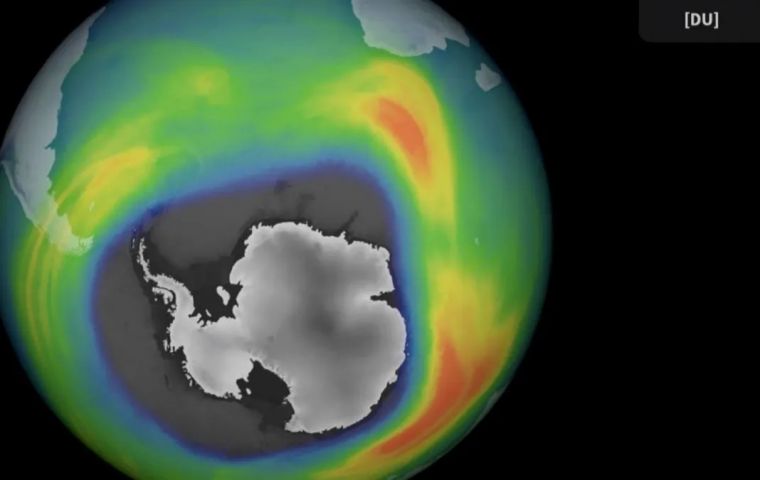MercoPress. South Atlantic News Agency
Copernicus satellite detected giant hole in ozone layer over Antarctica, three times the size of Brazil
 Space agencies like NASA and ESA operate satellites which measure chemicals in the atmosphere, providing information about climate and the ozone
Space agencies like NASA and ESA operate satellites which measure chemicals in the atmosphere, providing information about climate and the ozone The European Space agency Copernicus Sentinel satellite detected a giant hole in the ozone layer over Antarctica, as part of the EU's Environmental monitoring program. The hole which scientists call an “ozone depleted area” was 26 million square kilometers in size, roughly three times the size of Brazil.
The recording was made on 15 September and Claus Zehner the agency's mission manager admitted it was of the biggest ozone holes they've ever seen.
“The satellite measured trace gases in the atmosphere in order to monitor the ozone and climate. It showed that this year's ozone hole started earlier than usual, and had a big extension,” said Zehner. However experts believe the hole in the ozone is not likely to increase warming on the surface of Antarctica.
“It's not a concern for climate change,” said Zehner.
The ozone layer is a trace gas in the stratosphere, one of the four layers of the Earth's atmosphere.
It functions as a protective gas shield that absorbs ultraviolet radiation, protecting humans and ecosystems from dangerous amounts of UV. Most skin cancers are caused by exposure to high amounts of UV radiation, so anything that shields us from UV rays helps reduce cancer rates.
The size of the ozone hole over Antarctica fluctuates each year, opening each year in August and closing again in November or December.
Zehner said the ozone hole opens up because of the rotation of the Earth causing specials winds over the closed landmass of Antarctica.
“The winds create a mini climate, creating a shield over Antarctica preventing it from mixing with surrounding air. When the winds die down, the hole closes,” he said.
Scientists believe this year's big ozone hole could be due to the volcanic eruptions at Hunga Tongan in Tonga during December 2022 and January 2023.
“Under normal conditions, gas released from a volcanic eruption stays below the level of the stratosphere, but this eruption sent a lot of water vapor into the stratosphere,” said Zehner.
The water had an impact on the ozone layer through chemical reactions and changed its heating rate. The water vapor also contained other elements that can deplete ozone like bromine and iodine.
“There isn't much evidence the ozone hole this time is due to humans,” Zehner said.
While this year's Antarctic ozone hole was likely due to a volcanic eruption, scientists became aware that human activities were creating huge ozone holes in the 1970s.
Ground and satellite-based measurements detected the holes, which were caused by widespread use of chemicals called chlorofluorocarbons.
“The culprit behind ozone depletion was not aerosols in aerosol cans, but the propellants we use as gases to propel the solutions inside. These gaseous propellants contain chlorine, which is released high in the stratosphere and depletes the ozone,” said Jim Haywood, a professor of atmospheric science at University of Exeter in the UK.
The world took action after scientists raised alarm over the ozone holes, and quickly. In 1987, the Montreal Protocol was created to protect the ozone layer by phasing out the production of these harmful substances.
The good news is that the protocol was effective — ozone holes got smaller -- in the decades after ozone-depleting gas emissions were controlled.




Top Comments
Disclaimer & comment rules-

Read all commentsSharon Korman was wrong, as The Caroline “anticipatory self-defense” in international relations, which holds that it may be justified only in cases in which the “necessity of that self-defense ...
Oct 12th, 2023 - 03:51 pm 0https://en.wikipedia.org/wiki/Caroline_affair#
Whereas, Kelsen clearly states ”It makes no difference whether the annexation takes place after an occupatio bellica or not.“
Assessment of the Totality of Argentina’s Claim to Sovereignty
“Argentina failed to submit the dispute...there is little doubt that GB acquired definitive title to the Islands before 1982.”
after reviewing for Argentina’s claim, Argentina never developed title to the Islands.
Applying the rules, extinctive prescription
one could conclude this was a sufficient to extinguish Argentina's claim in spite diplomatic protests. The establishment of the world courts changed the situation so that diplomatic protests were no longer sufficient to keep Argentina's claim to alive.
The League of Nations and, later, the UN were capable of adjudicating the competing claims. ...
To avoid losing her claim her claim to the LON, the PCIJ or the ICJ....For over 50 years prior to the armed conflict of April 2, 1982, Argentina failed to submit the dispute
Applying the rules concerning the mode of extinctive prescription to GB results in a different conclusion. It involves possession,...However, since this was such a period of time, exceeding eighty years, one could conclude that this sufficient to extinguish Argentina's claim
Regardless of the conclusion reached above, however, the establishment of the world courts changed the situation so that diplomatic protests were no longer sufficient to keep Argentina's claim to sovereignty alive.”
The Falklands (Malvinas) Islands: An International Law Analysis of the Dispute Between Argentina and Great Britain Major James Francis Gravelle
MILITARY LAW REVIEW CONTEMPORARY INTERNATIONAL LEGAL ISSUES
Pamphlet NO. 27-100-107 HEADQUARTERS DEPARTMENT OF THE ARMY; Washington, D.C
Commenting for this story is now closed.
If you have a Facebook account, become a fan and comment on our Facebook Page!